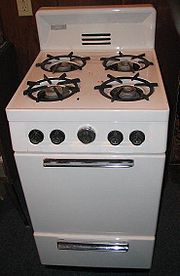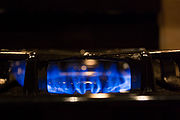
Gas stove
Encyclopedia

Cooking
Cooking is the process of preparing food by use of heat. Cooking techniques and ingredients vary widely across the world, reflecting unique environmental, economic, and cultural traditions. Cooks themselves also vary widely in skill and training...
, a gas stove is a cooker which uses natural gas
Natural gas
Natural gas is a naturally occurring gas mixture consisting primarily of methane, typically with 0–20% higher hydrocarbons . It is found associated with other hydrocarbon fuel, in coal beds, as methane clathrates, and is an important fuel source and a major feedstock for fertilizers.Most natural...
, propane
Propane
Propane is a three-carbon alkane with the molecular formula , normally a gas, but compressible to a transportable liquid. A by-product of natural gas processing and petroleum refining, it is commonly used as a fuel for engines, oxy-gas torches, barbecues, portable stoves, and residential central...
, butane
Butane
Butane is a gas with the formula C4H10 that is an alkane with four carbon atoms. The term may refer to any of two structural isomers, or to a mixture of them: in the IUPAC nomenclature, however, butane refers only to the unbranched n-butane isomer; the other one being called "methylpropane" or...
, liquefied petroleum gas or other flammable gas
Gas
Gas is one of the three classical states of matter . Near absolute zero, a substance exists as a solid. As heat is added to this substance it melts into a liquid at its melting point , boils into a gas at its boiling point, and if heated high enough would enter a plasma state in which the electrons...
as a fuel
Fuel
Fuel is any material that stores energy that can later be extracted to perform mechanical work in a controlled manner. Most fuels used by humans undergo combustion, a redox reaction in which a combustible substance releases energy after it ignites and reacts with the oxygen in the air...
source.
History
The first gas stoves were developed as early as the 1820s, but these remained isolated experiments. James Sharp patented a gas stove in Northampton, England in 1826 and opened a gas stove factory in 1836. At the World FairWorld fair
World Fair can refer to:* Expo , a large public exhibition* This World Fair, an American rock band...
in London
London
London is the capital city of :England and the :United Kingdom, the largest metropolitan area in the United Kingdom, and the largest urban zone in the European Union by most measures. Located on the River Thames, London has been a major settlement for two millennia, its history going back to its...
in 1851, a gas stove was shown, but only in the 1880s did this technology start to become a commercial success. The main factor for this delay was the slow growth of the gas pipe network
Pipeline transport
Pipeline transport is the transportation of goods through a pipe. Most commonly, liquids and gases are sent, but pneumatic tubes that transport solid capsules using compressed air are also used....
.
The first gas stoves were rather unwieldy, but soon the oven was integrated into the base and the size reduced to fit in better with the rest of the kitchen furniture. In the 1910s, producers started to enamel their gas stoves for easier cleaning. A high-end gas stove called the AGA cooker
AGA cooker
The AGA cooker is a stored-heat stove and cooker invented in 1929 by the Nobel Prize-winning Swedish physicist Gustaf Dalén , who was employed first as the chief engineer of the Swedish AGA company...
was invented in 1922 by Swedish Nobel
Nobel Prize
The Nobel Prizes are annual international awards bestowed by Scandinavian committees in recognition of cultural and scientific advances. The will of the Swedish chemist Alfred Nobel, the inventor of dynamite, established the prizes in 1895...
prize winner Gustaf Dalén
Gustaf Dalén
Nils Gustaf Dalén was a Swedish Nobel Laureate and industrialist, the founder of the AGA company and inventor of the AGA cooker and the Dalén light...
.
Ignition
Gas stoves today use two basic types of ignition sources, standing pilot and electric. A stove with a standing pilot has a small, continuously burning gas flame (called a pilot lightPilot light
thumb|right|Merker gas fired water heater from the 1930's, with pilot light clearly visible through the aperture in the front cover. The large opening allowed for the manual lighting of the pilot light by a lit match or taper...
) under the cooktop. The flame is between the front and back burners. When the stove is turned on, this flame lights the gas flowing out of the burners. The advantage of the standing pilot system is that it is simple and completely independent of any outside power source. A minor drawback is that the flames continuously consume fuel even when the stove is not in use. Early gas ovens did not have a pilot. One had to light these manually with a match [Stove Lightinghttp://www.pond5.com/stock-footage/65434/gas-stove.html]. If one accidentally left the gas on, gas would fill the oven and eventually the room. A small spark, such as an arc from a light switch being turned on, could ignite the gas, triggering a violent explosion. To prevent these types of accidents, oven manufacturers developed and installed a safety valve called a flame failure device for gas hobs and ovens. The safety valve depends on a thermocouple that sends a signal to the valve to stay open. If a draft blows out the flame or it goes out due to loss of gas pressure, the thermocouple cools and signals the valve to close, shutting off the gas supply. In gas ranges that come with a flame failure device, lighting when there's no power can prove to be a bit of a challenge because unless the user is quick at lighting a match and then turning on the gas valve, the flame failure device cuts off the gas supply within seconds if it senses that the burner isn't lit and there's not much of a point trying to light it once it has already cut off the gas supply.

Electric ignition stoves use electric sparks to ignite the surface burners. This is the "clicking sound" audible just before the burner actually lights. The sparks are initiated by turning the gas burner knob to a position typically labeled "LITE" or by pressing the 'ignition' button. Once the burner lights, the knob is turned further to modulate the flame size. Auto reignition
Auto reignition
Auto reignition is a process used in gas burners to control ignition devices based on whether a burner flame is lit. This information can be used to stop an ignition device from sparking, which is no longer necessary after the flame is lit...
is an elegant refinement: the user need not know or understand the wait-then-turn sequence. They simply turn the burner knob to the desired flame size and the sparking is turned off automatically when the flame lights. Auto reignition
Auto reignition
Auto reignition is a process used in gas burners to control ignition devices based on whether a burner flame is lit. This information can be used to stop an ignition device from sparking, which is no longer necessary after the flame is lit...
also provides a safety feature: the flame will be automatically reignited if the flame goes out while the gas is still on--for example by a gust of wind. If the power fails, surface burners must be manually match-lit.
Electric ignition for ovens uses a "hot surface" or "glow bar" ignitor. Basically it is a heating element that heats up to gas's ignition temperature. A sensor detects when the glow bar is hot enough and opens the gas valve.

